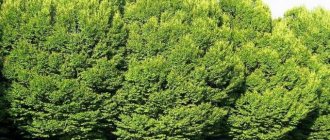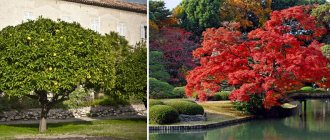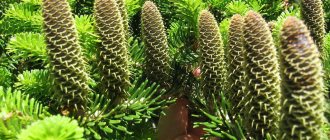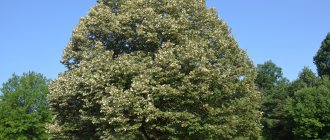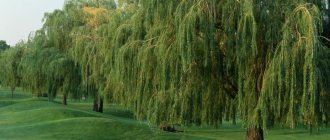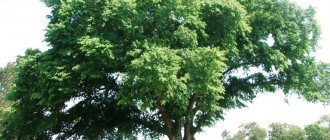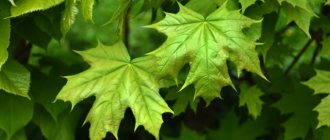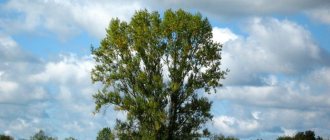Many gardeners often decorate their plots with flowering and spreading trees. Acacia is exactly such a tree. During flowering, it bears fragrant flowers, the aroma of which can be felt even when away from the tree. At night, the aroma of acacia flowers intensifies, which helps attract insects.
There are two versions of the origin of the name "Acacia". One Egyptian name is translated as “thorn”, and the second Greek name is “sharp”. In total, there are more than 1,300 species of acacia, most of which do not have thorns.
Features of acacia
Acacia is an evergreen tree, the height of which is about 25 m. Its trunk can reach about 120 cm in diameter. Moreover, some types of acacia are represented by shrubs. The branches are decorated with lush foliage with a feathery shape. The leaves are arranged whorled or alternately. Some plants have lanceolate, needle-shaped or widely spread petioles on their branches instead of foliage.
During flowering, inflorescences are formed on the branches, shaped like clusters or panicles. They include white, yellow or cream flowers. The bell-shaped calyx of the flowers consists of five petals. White or yellow flower whorls with 4 or 5 wings are tube-shaped.
Acacia is part of the Legume family. This is precisely the reason why, in place of pollinated flowers, oblong-shaped pods, which are fruits, are formed. In different species of such a plant, the fruits differ from each other, for example, they can be straight, flat, curved, large, opening, cylindrical or closed.
You can often see thorns on the branches of acacia. However, they are most often found on trees and shrubs growing in the south. The root system of such a tree is very powerful. In this case, the central root goes deep into the ground, and the lateral ones are at a shallow depth. The bark of a young tree is silver in color, but over the years it turns brown.
White acacia - to plant or not to plant?
Pink variety
Another variety of Robinia called sticky. The natural range is southeastern North America. Now you can find such trees in the south of Russia. It was called sticky because sticky glandular hairs are found:
- on the branches;
- leaf petioles;
- peduncle;
- on the axis of the inflorescences.
The acacia tree is decorated with a lush head of pink flowers with a delicate aroma. The main advantage of the tree is its double flowering per year. The first time is in late May - early June, and the second time in August.
The tree grows 30−60 cm per season. Main characteristics:
- the height of an adult tree is no more than 10 meters;
- the luxurious crown is spreading and lush;
- trunk in diameter no more than 40 cm;
- the tree bark is smooth and dark;
- large pink or pale lilac flowers do not have a strong odor, collected in a raceme of 7-15 flowers.
Robinia is a heat-loving plant, but one of its big advantages is its drought resistance and ability to grow on rocky soils.
Types of acacia with photos and names
Acacia is especially popular among gardeners and lovers of unusual landscape design. At the same time, the most widely distributed species and varieties in culture are:
Acacia Farnesiana
This spectacular shrub is found naturally on the Black Sea coast. Its height can vary from 2 to 4 m. The plant has brown bark that shimmers with silver. The uneven branches seem to be broken, while on most of them on the surface you can see not very much pubescence. Pairipinnate leaf blades consist of 2–8 branches.
Acacia Podalyriifolia
An adult tree can reach a height of about 5 m. As for bush-like forms, their height does not exceed 3 m. Small dense green leaf plates have a grayish-silver tint. Flowering begins in January and lasts until April. A large number of golden-yellow flowers are formed on the branches, which have a sharp and persistent aroma. Such a plant can suffer even due to a slight cold snap, with the minimum permissible air temperature being 10 degrees.
Acacia spectabilis
The height of an adult acacia can vary from 150 to 400 cm. The opening of rich yellow flowers is observed in July, while the tree blooms in November. The shape of the silvery-green leaf blades is pinnate. Large fruits are represented by pods that reach a size of about 18 centimeters. The southern variety of this species is extremely heat-loving; it can die when the temperature drops to 8 degrees and below. However, this plant is highly drought-resistant, and it also tolerates heat well (up to 35 degrees).
Red acacia (Acacia oxycedrus)
The name "red" means "beautiful". The height of such a shrub, as a rule, does not exceed 200 cm. During the flowering period, it is decorated with many yellowish flowers, which are collected in small groups (up to three pieces). The bush blooms in July, and flowering lasts until November. Since the plant has a powerful and large root system that goes deep into the soil, it thrives even during prolonged drought.
Longleaf acacia (Acacia longifolia)
The tree can reach a height of about 10 m in just five years of growth. This southern plant is decorated with dark green elongated leaf plates that are hard to the touch. Yellowish inflorescences form earrings. This tree is native to the USA and Australia. In the subtropics it is most widely distributed in culture. This type is used to prevent soil erosion. The foliage and flowers are used to produce green and yellow dye.
Also in nature you can find a large number of other types of acacia, which are quite interesting, for example: Acacia aneura, Ashby (Acacia ashbyae), Bailey (Acacia baileyana), Bordered (Acacia anceps), Leafless (Acacia aphylla), Varied-thorned ( Acacia ataxacantha) and many others.
Robinia pseudoacacia
There are also plants popularly called acacias. However, in fact, these trees belong to a completely different genus. These plants include Robínia Pseudoacácia, or white acacia - its fragrant flowers are painted white, as well as Caragana Arboréscens, or yellow acacia - it is decorated with rich yellow flowers. Such plants are resistant to frost, and they are quite widespread in Russia, and such “acacias” are found mainly in the southern and middle latitudes.
A unique tree, blooms from JUNE to NOVEMBER, honey plant, pink acacia. Robinia sticky.
Characteristic
What does acacia look like? The following is a detailed and detailed description of the tree.
Root system
Acacia has a powerful and developed root system.
This is due to the fact that in order to extract water and microelements from the soil , acacia roots have to climb to great depths.
The root system has a main shaft. In the upper layers of the soil it has strong branching; as the depth increases, it decreases.
To keep the roots healthy and functioning well , you need to ensure that the plant is watered correctly.
In spring and summer, acacia requires abundant watering ; in winter, its frequency should be reduced.
If you water heavily in winter, the roots of the plant will not be able to absorb water normally, which will lead to their rotting.
Trunk and bark
The acacia trunk reaches a height of 25 meters, the average value is 12 meters. It reaches 1.2 meters in diameter.
The surface of the tree trunk has longitudinal grooves .
The color of the bark varies from
dark gray to brown .
However, in young plants the bark is usually thin and smooth, has a green, light gray or light brown color, and a fissured surface. Acacia bark has beneficial properties and is used in folk medicine in the form of decoctions to treat gastritis or stomach ulcers (read about the beneficial and medicinal properties of acacia here).
Spread of acacia
Most acacia species are found in Africa, Australia and Asia. This plant is used to decorate greenhouses and gardens, and there are more than 50 flowering and ornamental species in the culture.
In Russia, such a plant can be found in the wild only in the Caucasus and southern latitudes. However, in most regions of Russia you can see deciduous shrubs, which are popularly called yellow or white acacia.
Planting acacia in open ground
It is recommended to plant common acacia in open ground in the spring. At the same time, in southern latitudes you can plant such a plant in the autumn. For planting, acacia seedlings growing in containers are used. It is recommended to choose the sunniest place for landing.
Prepare a planting hole, the width and depth of which should be about half a meter. After this, a drainage layer about 10 centimeters thick of sand is made at the bottom. At first, a young plant needs support, so do not forget to install it during planting.
The root system of the seedling is placed in the hole and carefully straightened out. Then fill it with loose soil, which must first be mixed with nitroammophos. Water.
We plant White Acacia in open ground.
Acacia care
You will have to care for the acacia only during the first two years after it is planted in the ground. After this, it only needs regular formative pruning. Remember that the root system reacts negatively to close proximity. That is why it is extremely undesirable to grow flowers near such a plant. He also needs to ensure timely weeding and loosening of the surface of the tree trunk circle.
An adult acacia needs to be watered only when there is a very long drought (no precipitation for 2 or 3 months). In order for a young tree to grow faster, the soil in the tree trunk circle should be moistened immediately after it dries. The plant is fed for the first time only 3 years after planting in open ground. Further fertilizing is carried out once every 3 years.
Reproduction methods
Acacia can be propagated at home by cuttings and seeds. Seed material remains viable for about 2 years. However, it is very difficult to grow seedlings from seeds with your own hands. In this regard, it is recommended to propagate acacia by cuttings or you can purchase a ready-made seedling.
Growing from seeds
In order to grow such a plant from seeds, you will need to put in a lot of effort. Seed material needs to be steamed before sowing; for this, it is immersed in hot water (at least 80 degrees). The shell of each seed must be cut very carefully. Thanks to this preparation, young shoots will appear much faster.
How to grow acacia from seeds. White acacia in the Middle Zone. Website "Garden World"
Cuttings
The easiest way to propagate acacia is by cuttings. In this case, both root shoots and stems can be used to prepare cuttings. It is held in spring. The length of the cutting should be about 10 centimeters, and it should be cut from the middle of the stem.
One end of the cutting should be dipped in a root growth stimulating agent. For rooting, it is planted in a container filled with substrate, and then the cutting is placed in a greenhouse, where the air temperature should not fall below 22 degrees. The cuttings can be planted in the garden in the autumn.
To propagate acacia by root cuttings, first in spring it is necessary to remove part of the adult bush from the ground. Select a strong, healthy root and cut it into stems, the length of which should be about 15 centimeters and the diameter at least 0.5 centimeters. For rooting, the chibuki are planted at an angle in sandy soil. Planting in a permanent place can be done with the onset of autumn.
Planting and care
Since robins are fairly resilient and unpretentious plants, they are quite easy to grow. Only two conditions are important - plenty of sun and lack of groundwater in the place chosen for planting. If your site is located in a swamp or forest, then you will have to abandon the idea of \u200b\u200bgrowing acacia.
White acacia reproduces by root suckers and seeds. Moreover, the second method does not require as much time as it seems at first glance. To begin with, before planting, the seeds need to be treated with boiling water: place the seeds prepared for planting in it for 5-10 seconds, and then throw them into cold water. This is done so that the outer shell of the seeds cracks and they swell.
Seeds treated in this way should be sown immediately. This can be done in April in a box or in May in a greenhouse. For the growth of good seedlings, a high temperature of up to 20 degrees is required, and they must live in a cold spring in a greenhouse with small tomato bushes. In early to mid-June, the plants are planted in a separate illuminated bed.
Diseases and pests
If you provide acacia with the most optimal conditions for growth, it will be very resistant to a wide variety of diseases. However, pests can settle on such a tree and injure the stems, trunk, foliage and branches. To save the plant, pests can be collected from it manually or destroyed by treating it with a suitable pesticide.
Sometimes it happens that the foliage on a bush turns yellow and dries out. This is a sign of a plant being damaged by a fungal disease, which is caused by the pathogenic fungus Septoria caraganae (Jacz.) Died. In infected acacia, flowering stops and leaves fly off. Diseased leaf plates and branches must be trimmed, after which the plant is treated with Bordeaux mixture.
Meaning and Application
Acacia is an ornamental plant; it is also widely used in everyday life:
- Some species are highly decorative. Such acacias are grown in the garden or at home.
- Climbing species are used to make hedges in country houses and dachas.
- The plant is able to strengthen a ravine or slope due to its extensive, powerful root system.
- The tree is an excellent honey plant, so it is planted along the edge of an apiary meadow. Honey has a pleasant taste and is very healthy.
- In alternative medicine, foliage, flowers and bark are used. The flowers are collected and dried from the last days of May to the first days of June. A decoction is prepared from them, which is taken as prescribed by a doctor for myositis, migraines, osteochondrosis, to strengthen the immune system, etc.
- Well-bending dense wood is used to make parquet, doors and exclusive interior items. Such wood is not suitable for cutting due to its increased density, but some craftsmen still make amazing jewelry and souvenirs from it.
White acacia. Use in folk medicine. Nervous disorders and more.
How to use
Products based on white acacia are used in both folk and traditional medicine. Pharmacies sell medicinal preparations and individual parts of the plant - flowers, leaves, bark. Infusions, decoctions, compresses, and lotions are made from this medicinal raw material.
The plant is used as a medicinal raw material to relieve colds and reduce fever. An infusion of white acacia flowers has an expectorant effect, so it is often used to treat coughs.
A decoction of the bark and leaves of the plant helps with gastrointestinal diseases, reduces the acidity of gastric juice and copes with intestinal obstruction. It is often used to treat gallbladder diseases, ulcers and gastritis.
Products based on white acacia are used to treat diseases of the genitourinary system. Infusions and decoctions of the plant have an anti-inflammatory and hemostatic effect; they are often used to treat diseases of the female reproductive system.
An alcoholic tincture of the plant helps with osteochondrosis, rheumatism and radiculitis. It is used externally in the form of compresses, lotions, and rubbing.
White acacia tincture is used as a powerful expectorant, which effectively helps with any cough.
Cough tincture
Ingredients:
- white acacia flowers - 10 g;
- water - 250 ml.
How to cook:
- Grind the dried flowers and add water.
- Bring to a boil in a water bath.
- After 5-7 minutes, remove from heat, cover with a lid and let sit for half an hour.
- Strain the cooled infusion through a sieve.
Take 1 tablespoon of infusion every three hours.
The product thins mucus and removes it from the bronchi. Helps eliminate paroxysmal cough.
A decoction of white acacia leaves is used as an antipyretic. It is used to treat viral diseases and inflammatory processes.
A decoction of the white acacia plant to reduce fever
Ingredients:
- white acacia leaves - 30 gr.;
- water - 300 ml.
We recommend reading: Useful properties and contraindications of duckweed, how to use
How to cook:
- Mash the dry leaves with a rolling pin, pour boiling water over them and place on low heat.
- Cook for 5-7 minutes, then remove from heat and cool.
Take 10 ml 3 times a day before meals.
This folk recipe will help you quickly get back on your feet after the first signs of a cold appear. The product reduces fever and helps cope with the inflammatory process.
To treat gastrointestinal diseases, an alcoholic infusion of leaves and a decoction of white acacia bark are often used.
Tincture on the white acacia plant for peptic ulcers
Ingredients:
- white acacia leaves - 20 g;
- medical alcohol - 250 ml.
How to cook:
- Grind the dry leaves, place them in a glass jar and fill with alcohol.
- Close the lid tightly and store in a dark place for 5-7 days.
- Strain the finished tincture before use.
Dilute 20 drops of tincture in a tablespoon of water and take 3 times a day before meals.
The product helps relieve pain, reduces inflammation and promotes scarring of stomach and intestinal ulcers.
Decoction for gastritis
Ingredients:
- white acacia bark - 50 g;
- water - 500 ml.
How to cook:
- Crumble the bark, add water and bring to a boil over low heat.
- Cook for 10-15 minutes, then remove from heat.
Take a hot decoction of 50 ml half an hour before meals 3 times a day.
The decoction has an analgesic effect and reduces the acidity of gastric juice.
A disease such as osteochondrosis can be treated with alcohol tincture. It is used externally to rub the sore spot.
Tincture for osteochondrosis
Ingredients:
- white acacia flowers - 100 gr.;
- vodka - 500 ml.
How to cook:
- Mash dry acacia flowers, pour them into a glass container and fill with vodka.
- Leave in a cool, dark place for 2-3 weeks, shake occasionally.
- Strain the finished tincture.
Rub the sore area with the tincture twice a day.
The product warms up the sore spot and relieves pain in muscles and joints.
Infusions and decoctions of white acacia effectively cope with diseases of the genitourinary system. They have diuretic, antispasmodic and anti-inflammatory effects.
Infusion from the white acacia plant for cystitis
Ingredients:
- wheatgrass root - 15 g;
- white acacia flowers - 20 gr.;
- calendula flowers - 15 g;
- water - 300 ml.
How to cook:
- Grind the dry ingredients, add water and place on low heat.
- Bring the broth to a boil, stir for 8-10 minutes, then remove from heat.
- Cover with a lid, wrap a towel on top and let it brew for an hour.
- Strain the cooled broth and dilute with boiling water to the original volume of 300 ml.
We recommend reading: Indian cucumber - medicinal properties and contraindications, cultivation
Take 50 ml 3 times a day half an hour before meals.
Result: The infusion soothes the mucous membrane of the bladder and relieves pain.
Acacia in landscape design
In landscape design, decorative species and varieties of acacia are very popular. It is recommended to plant low-growing, lush-flowering varieties in the garden plot. You can create a hedge from acacia. The thorns will make the fence an insurmountable obstacle, and since the plant climbs well, it will turn out to be very dense.
Silver acacia, which is very similar to mimosa, is also suitable for decorating a garden plot. It looks impressive both as a solo plant and in a group with other crops.
Yellow or white acacia is often used to form arbors or arches. Since the plant is creeping and very flexible, it quickly and effectively weaves through all available space. During flowering, its branches are decorated with fragrant inflorescences. This plant tolerates shaping pruning well and can easily be made to grow in the desired direction.
Progress of the lesson:
Look at this tree. This is white acacia.
Nowadays acacia can be found on many city streets, but once upon a time it grew only overseas, in distant America. This was a long time ago, back when there were kings. One such king sent his gardener on a journey to find strange plants. That’s when the acacia seeds moved across the ocean and the acacia grew in a new place. Years have passed. Now it is no longer a king from France, but a scientist from our country who decided to plant acacia in our country. We liked this tree.
Let's remember the structure of a tree. Name the parts of the tree. (Children's answers). Crown, trunk, roots.
People love white acacia very much for its beautiful and fragrant flowers. Both poems and songs are written about “fragrant bunches of white acacia.” In addition, acacia blooms not once a year, like most trees, but twice: in early summer and autumn. Beekeepers love acacia for its abundant and generous flowering. Who are beekeepers? (Children's answers). People who breed bees. And the bees are happy to try - both in summer and autumn they collect honey from acacias. Therefore, the acacia tree is considered a honey plant. Honey plant is the name given to plants from which bees collect and carry honey. Honey plant - they carry honey. Repeat this word and try to remember. Acacia honey is tasty, aromatic, healing and very transparent. Take a look, you might think that there is none in the glass at all. Later we will taste acacia honey. I said that acacia honey is healing. What does it mean? (Children's answers). Healing means healing, healing from diseases.
And white acacia leaves are good food for pets. Let's remember what pets you know? (Children's answers).
